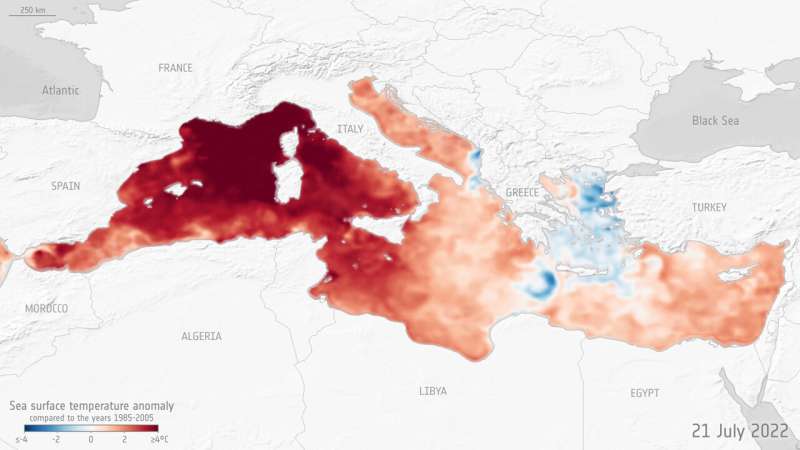Mediterranean Sea hit by marine heatwave
Marine heatwaves are extreme rises in ocean temperature over an extended period of time. Their magnitude and frequency have harmful impacts on marine ecosystems, threaten marine biodiversity and negatively impact fisheries, aquaculture and tourism industries.
Higher water temperatures associated with marine heatwaves can also cause extreme weather events such as tropical storms and hurricanes and disrupt the water cycle, making floods, droughts and wildfires on land more likely.
As global ocean temperatures continue to rise, marine heatwaves have become more widespread and are only expected to increase in intensity, duration and frequency in the future owing to human-induced climate change.
Predicting marine heatwave occurrence and duration, as well as understanding their impacts on marine ecosystems, is essential and can help protect ecosystems and local communities.
CAREHeat (deteCtion and threAts of maRinE Heat waves) aims to develop novel strategies to identify marine heatwaves, assess their status and trends and understand their impact on marine life.
The project, which began in March 2022, used near-real time sea surface temperature data available from the Copernicus Marine Service, and has been able to detect and monitor the Mediterranean marine heatwave that occurred this summer.
The team found that this particularly extreme heatwave event started in the second half of April and stretched across the central and northwest Mediterranean Sea. In the area, sea surface temperature increases accelerated around 10 May and, in nearly 10 days, an abrupt change in temperature—from 16°C to 22°C—was observed.
In the Ligurian Sea—an arm of the Mediterranean—the maximum intensity of the heatwave was reached on 21 July, when the mean anomaly reached 5°C. As of 13 September, the heatwave in the Mediterranean is still present.
“We are still observing an averaged sea surface temperature anomaly of around 2°C, which intensified in the northwest Mediterranean where the anomaly is higher than 4°C,” commented Rosalia Santoleri, CAREHeat Project Coordinator.
The team will continue to monitor the evolution of this heatwave with the aim to understand how the temperature signal propagates below the surface, what are the drivers of this long-lasting extreme event and what impact it has on the Mediterranean marine ecosystem.
Compound extreme events stress the oceans
Copernicus Marine Service: marine.copernicus.eu/
Citation:
Mediterranean Sea hit by marine heatwave (2022, September 22)
retrieved 22 September 2022
from https://phys.org/news/2022-09-mediterranean-sea-marine-heatwave.html
This document is subject to copyright. Apart from any fair dealing for the purpose of private study or research, no
part may be reproduced without the written permission. The content is provided for information purposes only.

Marine heatwaves are extreme rises in ocean temperature over an extended period of time. Their magnitude and frequency have harmful impacts on marine ecosystems, threaten marine biodiversity and negatively impact fisheries, aquaculture and tourism industries.
Higher water temperatures associated with marine heatwaves can also cause extreme weather events such as tropical storms and hurricanes and disrupt the water cycle, making floods, droughts and wildfires on land more likely.
As global ocean temperatures continue to rise, marine heatwaves have become more widespread and are only expected to increase in intensity, duration and frequency in the future owing to human-induced climate change.
Predicting marine heatwave occurrence and duration, as well as understanding their impacts on marine ecosystems, is essential and can help protect ecosystems and local communities.
CAREHeat (deteCtion and threAts of maRinE Heat waves) aims to develop novel strategies to identify marine heatwaves, assess their status and trends and understand their impact on marine life.
The project, which began in March 2022, used near-real time sea surface temperature data available from the Copernicus Marine Service, and has been able to detect and monitor the Mediterranean marine heatwave that occurred this summer.
The team found that this particularly extreme heatwave event started in the second half of April and stretched across the central and northwest Mediterranean Sea. In the area, sea surface temperature increases accelerated around 10 May and, in nearly 10 days, an abrupt change in temperature—from 16°C to 22°C—was observed.
In the Ligurian Sea—an arm of the Mediterranean—the maximum intensity of the heatwave was reached on 21 July, when the mean anomaly reached 5°C. As of 13 September, the heatwave in the Mediterranean is still present.
“We are still observing an averaged sea surface temperature anomaly of around 2°C, which intensified in the northwest Mediterranean where the anomaly is higher than 4°C,” commented Rosalia Santoleri, CAREHeat Project Coordinator.
The team will continue to monitor the evolution of this heatwave with the aim to understand how the temperature signal propagates below the surface, what are the drivers of this long-lasting extreme event and what impact it has on the Mediterranean marine ecosystem.
Compound extreme events stress the oceans
Copernicus Marine Service: marine.copernicus.eu/
Citation:
Mediterranean Sea hit by marine heatwave (2022, September 22)
retrieved 22 September 2022
from https://phys.org/news/2022-09-mediterranean-sea-marine-heatwave.html
This document is subject to copyright. Apart from any fair dealing for the purpose of private study or research, no
part may be reproduced without the written permission. The content is provided for information purposes only.
